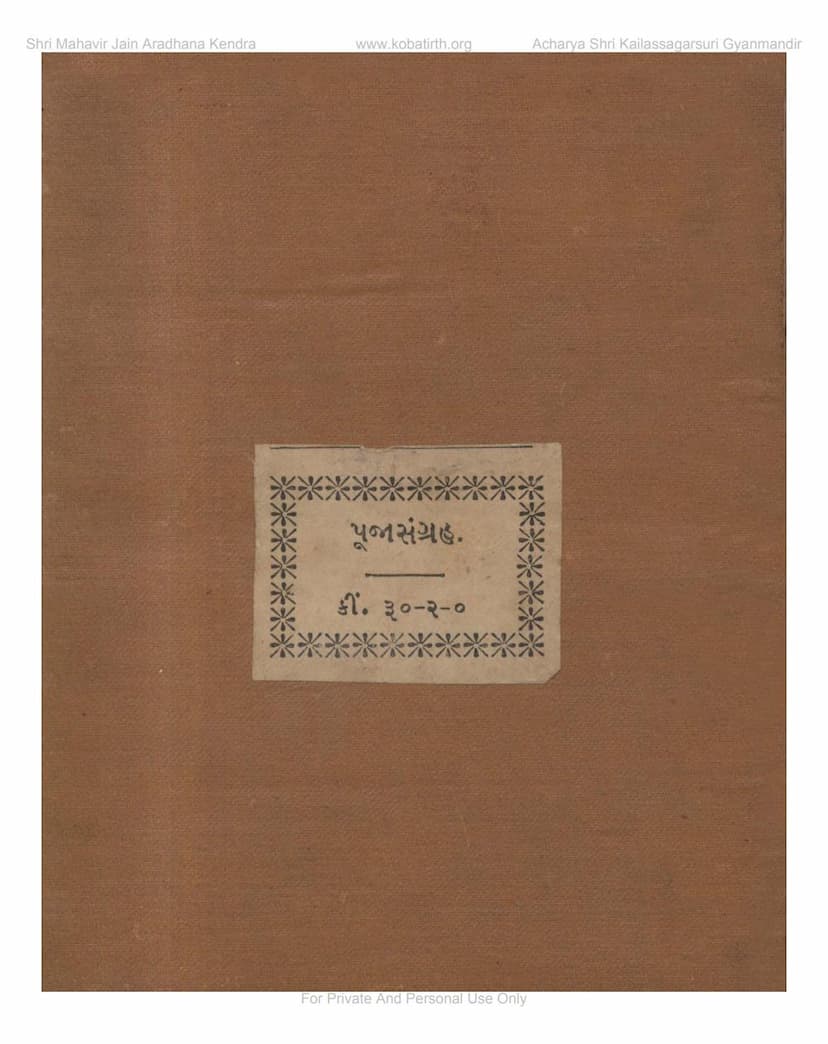Pooja Sangraha Part 1
Added to library: September 2, 2025

Summary
This is a summary of the Jain text "Pooja Sangraha Part 1" by Buddhisagar, published by Jainoday Buddhisagar Samaj Sanand.
Overview:
The book is a collection of Jain rituals and prayers, primarily focusing on different types of Pooja (worship) dedicated to the Tirthankaras, especially Lord Mahavir. It includes detailed instructions and verses for performing these rituals. The text is presented in Gujarati.
Key Contents:
- Page 1-3: Title page and introductory information, indicating the author (Munishri Sagardasji, disciple of Munishri Sukh Sagardasji), publisher, and publication details (Dhir Samvat 2432 - Samvat 1961). The price is also mentioned.
- Page 4: Dedication (Arpanpatrika): The book is dedicated to Seth Chhaganlal Bechardas, acknowledging his virtues and devotion to Jinshwar (Tirthankaras). The Jainoday Buddhisagar Samaj expresses their respect and offers this small book of Pooja.
- Page 6-27: Snatra Pooja (Abhishekam Pooja): This section describes the elaborate ritual of bathing the idol of a Tirthankara.
- Preparation: It details the use of Panchamrit (milk, curd, ghee, saffron, water), the placement of kalash (pots), setting up a throne, and placing the idols of Tirthankaras and Siddha-chakra.
- Ritual Steps: It outlines the process of offering flowers (kusumanjali), chanting verses, performing the abhishek (bathing) with water, drying the idol, applying sandalwood paste for puja, performing Aarti (waving of lamps), and offering other items.
- Materials: The text mentions the use of flowers, sandalwood, saffron, water, a conch shell, a mirror, a fan, a bell, and other ritualistic items. It also suggests using fine garments (vastra) instead of cotton strings (nadachhadi) for better offerings if possible.
- Verses and Songs: Throughout the Snatra Pooja, there are verses in various meters (doha, dhal, dhrutvilambit) describing the auspicious occasion of the Tirthankara's birth, the divine processions, and the devotion of the gods and goddesses.
- Specific Pujas: Sections like "Kusumanjali Dhal" (offering of flowers) are repeated, dedicating each offering to specific Tirthankaras.
- Chaiyyavandan: Instructions are given for performing Chaiyyavandan (veneration of the shrine) with specific verses and prayers.
- Upasargahar Stavan: A prayer for warding off afflictions is included.
- Jinvani: The text emphasizes the importance of knowledge and devotion through prayers and verses.
- Page 28-54: Ashtaprakari Pooja (Eight-fold Worship): This section details the eight types of worship:
- Jal Pooja (Water Worship): Offering pure water.
- Chandan Pooja (Sandalwood Worship): Offering sandalwood paste.
- Pushpa Pooja (Flower Worship): Offering flowers.
- Dhup Pooja (Incense Worship): Offering incense.
- Deep Pooja (Lamp Worship): Offering lamps.
- Akshat Pooja (Unbroken Rice Worship): Offering unbroken rice.
- Naivedya Pooja (Offering of Food): Offering sweets and food items.
- Phal Pooja (Fruit Worship): Offering fruits. Each of these pujas is explained with specific verses and their spiritual significance, emphasizing the purification of the soul and the attainment of liberation. The verses often reflect on the ephemeral nature of the world and the importance of spiritual practice.
- Page 55-70: Vastuk Pooja (Worship related to a dwelling or temple): This section describes a specific type of puja related to a house or temple, often dedicated to Lord Parshvanath.
- Dedication to Sankheshwar Parshvanath: The text highlights the worship of Lord Parshvanath of Sankheshwar.
- Significance: It explains how performing this puja brings prosperity, happiness, and removes ailments. It also differentiates between auspicious (shubh) and inauspicious (ashubh) Vastuk Puja, advising against practices associated with other religions (like Brahmanical rituals).
- Detailed Rituals: It outlines how to perform the Vastuk Puja with specific items and prayers.
- Guru Parampara: The text mentions the lineage of gurus, including Hirvijay Suri, Sahej Sagardasji, Ravi Sagardasji, and Sukh Sagardasji, emphasizing the lineage of spiritual transmission.
- Specific Rituals: The last part of this section provides instructions for conducting the Vastuk Puja with eight snatriyas (performers) each holding specific items. It also mentions the benefits of performing this puja for the householder and the entire community.
- Page 71: Advertisement: This page contains advertisements for other books, including "Kanyavikray Dosh" and "Pooja Sangraha" (by Munishri Buddhisagar), and lists the contact details for purchasing them.
Overall Theme:
The book serves as a guide for Jain devotees to perform various types of worship with devotion and understanding of their spiritual significance. It emphasizes the purification of the soul, the eradication of karmic bonds, and the ultimate goal of attaining liberation (moksha) through right faith, knowledge, and conduct, as prescribed in Jainism. The language is poetic and devotional, designed to inspire spiritual reflection and practice.